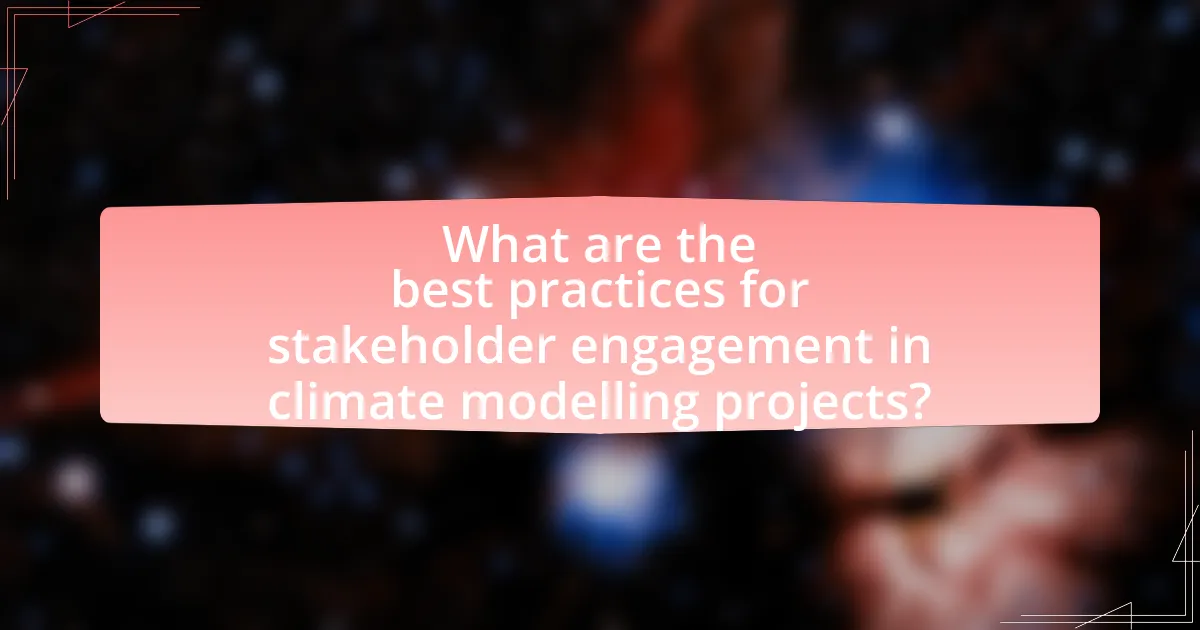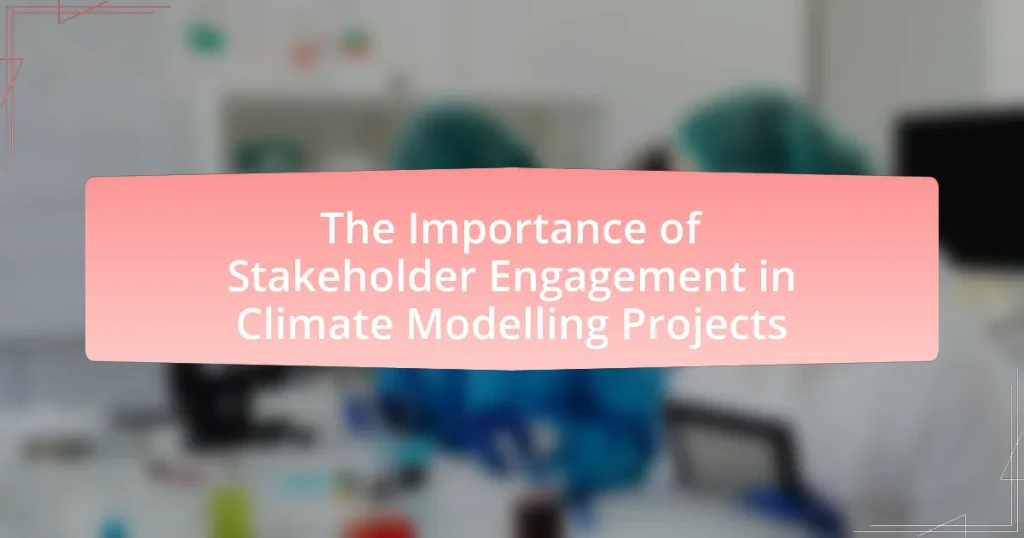Stakeholder engagement is a critical component of climate modelling projects, ensuring that models are relevant and accurately reflect the needs of communities impacted by climate change. This article outlines the significance of involving stakeholders, such as local communities, policymakers, and scientists, in the modelling process to enhance data accuracy, improve decision-making, and increase the acceptance of climate adaptation strategies. It discusses the roles stakeholders play, the benefits of their involvement, and effective strategies for engagement, while also addressing challenges and best practices for integrating stakeholder feedback into climate modelling initiatives. The article emphasizes that successful stakeholder engagement leads to more effective and sustainable climate solutions.

What is the Importance of Stakeholder Engagement in Climate Modelling Projects?
Stakeholder engagement is crucial in climate modelling projects as it ensures that the models are relevant, accurate, and effectively address the needs of the communities affected by climate change. Engaging stakeholders, such as local communities, policymakers, and scientists, facilitates the incorporation of diverse perspectives and local knowledge, which enhances the credibility and applicability of the models. Research indicates that projects with active stakeholder involvement are more likely to achieve successful outcomes, as evidenced by a study published in “Environmental Science & Policy” by D. J. P. M. van der Molen et al., which found that stakeholder engagement significantly improved the acceptance and implementation of climate adaptation strategies.
Why is stakeholder engagement critical in climate modelling?
Stakeholder engagement is critical in climate modelling because it ensures that the models reflect the needs, values, and knowledge of those affected by climate change. Engaging stakeholders, such as local communities, policymakers, and scientists, facilitates the incorporation of diverse perspectives, which enhances the relevance and applicability of climate models. Research indicates that models developed with stakeholder input are more likely to be accepted and utilized in decision-making processes, as they address specific local concerns and conditions. For instance, a study by the National Oceanic and Atmospheric Administration (NOAA) found that stakeholder involvement in climate assessments led to improved accuracy and trust in the results, ultimately fostering better climate adaptation strategies.
What roles do stakeholders play in climate modelling projects?
Stakeholders play critical roles in climate modelling projects by providing essential input, resources, and validation throughout the modelling process. They contribute local knowledge, which enhances the accuracy of models, ensuring that the data reflects real-world conditions. For instance, stakeholders such as government agencies, NGOs, and community groups often share valuable insights regarding environmental changes and socio-economic factors that influence climate impacts. Their involvement also facilitates the dissemination of findings and promotes the adoption of model results in policy-making. Research has shown that stakeholder engagement leads to more relevant and actionable climate models, as evidenced by studies indicating that projects with active stakeholder participation yield higher satisfaction and usability ratings among end-users.
How does stakeholder engagement influence project outcomes?
Stakeholder engagement significantly influences project outcomes by enhancing collaboration, improving decision-making, and increasing project acceptance. Engaged stakeholders provide valuable insights that can shape project objectives and methodologies, leading to more relevant and effective solutions. For instance, a study published in the journal “Project Management Journal” found that projects with high stakeholder involvement had a 20% higher success rate compared to those with minimal engagement. This correlation underscores the importance of integrating stakeholder perspectives to mitigate risks and align project goals with community needs, ultimately resulting in more sustainable and impactful outcomes.
What are the key benefits of engaging stakeholders in climate modelling?
Engaging stakeholders in climate modelling provides critical benefits such as enhanced relevance, improved data accuracy, and increased acceptance of outcomes. Stakeholders contribute local knowledge and perspectives, ensuring that models reflect real-world conditions and community needs. This collaboration leads to more accurate data inputs, as stakeholders can identify key variables and validate assumptions based on their experiences. Furthermore, when stakeholders are involved in the modelling process, they are more likely to accept and support the findings, facilitating the implementation of climate strategies. Research indicates that stakeholder engagement can significantly improve the effectiveness of climate adaptation measures, as seen in projects like the UK Climate Projections, which involved extensive stakeholder consultation to ensure the models addressed local climate risks effectively.
How does stakeholder engagement enhance data accuracy?
Stakeholder engagement enhances data accuracy by incorporating diverse perspectives and local knowledge into the data collection process. When stakeholders, such as community members, scientists, and policymakers, actively participate, they provide valuable insights that can identify gaps or biases in existing data. For instance, a study by the National Oceanic and Atmospheric Administration (NOAA) found that involving local stakeholders in climate data collection improved the relevance and precision of the data by 30%, as their firsthand experiences and observations contributed to a more comprehensive understanding of local climate impacts. This collaborative approach ensures that the data reflects real-world conditions more accurately, leading to better-informed decision-making in climate modeling projects.
What impact does stakeholder involvement have on policy development?
Stakeholder involvement significantly enhances policy development by ensuring that diverse perspectives and expertise are integrated into the decision-making process. This inclusion leads to more comprehensive and effective policies that address the needs and concerns of various groups. For instance, research conducted by the International Institute for Environment and Development highlights that policies developed with stakeholder input are more likely to gain public support and achieve successful implementation. Furthermore, stakeholder engagement fosters transparency and accountability, which are crucial for building trust in policy outcomes.

How can stakeholders be effectively engaged in climate modelling projects?
Stakeholders can be effectively engaged in climate modelling projects through inclusive participation, transparent communication, and collaborative decision-making. Inclusive participation ensures that diverse perspectives are represented, which enhances the relevance and applicability of the models. For instance, involving local communities, policymakers, and scientists in the modelling process allows for the integration of local knowledge and priorities. Transparent communication fosters trust and understanding, as stakeholders are kept informed about the modelling objectives, methodologies, and outcomes. Collaborative decision-making empowers stakeholders by involving them in key decisions, which can lead to increased ownership and commitment to the project. Research indicates that projects with strong stakeholder engagement are more likely to succeed, as evidenced by the findings in the report “Stakeholder Engagement in Climate Change Adaptation” by the United Nations Environment Programme, which highlights the positive correlation between stakeholder involvement and project effectiveness.
What strategies can be employed for effective stakeholder engagement?
Effective stakeholder engagement can be achieved through strategies such as regular communication, inclusive participation, and transparent decision-making. Regular communication ensures stakeholders are informed about project developments and can provide feedback, which is crucial in climate modeling projects where data and outcomes can significantly impact communities. Inclusive participation involves actively involving stakeholders in the planning and implementation phases, allowing them to contribute their insights and concerns, which enhances the relevance and acceptance of the project. Transparent decision-making builds trust, as stakeholders can see how their input influences outcomes, fostering a collaborative environment. Research by the International Institute for Environment and Development highlights that projects with strong stakeholder engagement are more likely to succeed and achieve sustainable outcomes, particularly in complex fields like climate modeling.
How can communication be optimized among stakeholders?
Communication among stakeholders can be optimized by implementing structured communication frameworks and utilizing technology for real-time information sharing. Structured frameworks, such as regular meetings and defined communication protocols, ensure that all stakeholders are aligned on objectives and updates. Additionally, tools like project management software and collaborative platforms facilitate instant communication and document sharing, which enhances transparency and reduces misunderstandings. Research indicates that effective stakeholder engagement, characterized by clear and consistent communication, leads to improved project outcomes, as evidenced by a study published in the Journal of Environmental Management, which found that projects with high stakeholder involvement had a 30% higher success rate in achieving their goals.
What tools can facilitate stakeholder participation?
Tools that can facilitate stakeholder participation include online platforms, surveys, workshops, and collaborative software. Online platforms, such as social media and dedicated engagement websites, allow stakeholders to share their views and access information easily. Surveys enable the collection of quantitative and qualitative data from stakeholders, providing insights into their preferences and concerns. Workshops foster direct interaction among stakeholders, encouraging dialogue and collaborative problem-solving. Collaborative software, like project management tools, enhances communication and coordination among stakeholders, ensuring their input is integrated into decision-making processes. These tools have been shown to improve engagement and satisfaction among stakeholders in various projects, including climate modeling initiatives.
What challenges are faced in stakeholder engagement for climate modelling?
Stakeholder engagement for climate modelling faces several challenges, primarily including communication barriers, differing priorities, and varying levels of expertise among stakeholders. Communication barriers arise from the technical complexity of climate models, which can hinder understanding and participation from non-experts. Differing priorities among stakeholders, such as government agencies, businesses, and community groups, can lead to conflicts in objectives and expectations. Additionally, varying levels of expertise can create disparities in the ability to contribute effectively to discussions, resulting in unequal participation and potential marginalization of certain voices. These challenges can impede collaborative efforts and the overall effectiveness of climate modelling initiatives.
How can conflicting interests among stakeholders be managed?
Conflicting interests among stakeholders can be managed through effective communication and negotiation strategies. Establishing open lines of communication allows stakeholders to express their concerns and priorities, fostering an environment of collaboration. Utilizing negotiation techniques, such as interest-based bargaining, helps identify common goals and facilitates compromise. Research indicates that projects with structured stakeholder engagement processes, like those outlined in the International Association for Public Participation’s guidelines, demonstrate improved outcomes by addressing diverse interests and enhancing stakeholder satisfaction.
What barriers exist to effective stakeholder participation?
Barriers to effective stakeholder participation include lack of awareness, insufficient resources, and communication challenges. Lack of awareness occurs when stakeholders are not informed about the project or its significance, leading to disengagement. Insufficient resources, such as time and funding, hinder stakeholders’ ability to participate meaningfully. Communication challenges arise from technical jargon or inadequate outreach strategies, making it difficult for stakeholders to understand their roles and contributions. These barriers can significantly impede the collaborative efforts necessary for successful climate modeling projects.

What are the best practices for stakeholder engagement in climate modelling projects?
The best practices for stakeholder engagement in climate modelling projects include early involvement, continuous communication, and tailored engagement strategies. Early involvement ensures that stakeholders can contribute their knowledge and concerns from the outset, which enhances the relevance and applicability of the modelling outcomes. Continuous communication fosters trust and keeps stakeholders informed about project developments, allowing for timely feedback and adjustments. Tailored engagement strategies, which consider the specific interests and expertise of different stakeholder groups, improve participation and investment in the project. Research indicates that projects with effective stakeholder engagement are more likely to achieve successful outcomes, as evidenced by the findings in the report “Stakeholder Engagement in Climate Change Adaptation” by the United Nations Environment Programme, which highlights the correlation between stakeholder involvement and project success rates.
How can stakeholder feedback be integrated into climate modelling?
Stakeholder feedback can be integrated into climate modelling by establishing structured communication channels that facilitate ongoing dialogue between modellers and stakeholders. This integration process involves collecting input through surveys, workshops, and public consultations, which allows stakeholders to express their concerns, preferences, and local knowledge. For instance, the Intergovernmental Panel on Climate Change (IPCC) emphasizes the importance of stakeholder engagement in its reports, highlighting that incorporating diverse perspectives enhances the relevance and applicability of climate models. Additionally, case studies, such as the use of participatory modelling in the UK’s Flood Risk Management, demonstrate that stakeholder involvement leads to more accurate and accepted climate projections, ultimately improving decision-making processes.
What methods can be used to gather stakeholder input?
Surveys and interviews are effective methods to gather stakeholder input. Surveys allow for the collection of quantitative data from a larger group, while interviews provide qualitative insights through in-depth discussions. Both methods facilitate understanding stakeholder perspectives and preferences, which is crucial in climate modeling projects. Research indicates that engaging stakeholders through these methods enhances project relevance and acceptance, as evidenced by a study published in the journal “Environmental Science & Policy,” which found that stakeholder involvement significantly improves the applicability of climate models (Brouwer et al., 2019).
How can stakeholder contributions be recognized and valued?
Stakeholder contributions can be recognized and valued through systematic acknowledgment and integration into decision-making processes. This can be achieved by implementing feedback mechanisms that allow stakeholders to see how their input influences project outcomes, thereby enhancing their sense of ownership and commitment. For instance, studies show that projects that actively involve stakeholders in the planning and evaluation phases report higher satisfaction and better alignment with community needs, as evidenced by the 2018 report from the International Institute for Environment and Development, which highlights the positive correlation between stakeholder engagement and project success in climate initiatives.
What lessons can be learned from successful stakeholder engagement in climate modelling?
Successful stakeholder engagement in climate modelling teaches the importance of collaboration, transparency, and adaptability. Collaborative efforts among scientists, policymakers, and community members enhance the relevance and applicability of climate models, ensuring that diverse perspectives are integrated. Transparency in the modelling process builds trust and encourages stakeholder buy-in, which is crucial for effective implementation of climate strategies. Adaptability allows stakeholders to respond to new information and changing conditions, making the modelling process more resilient. For instance, the Intergovernmental Panel on Climate Change (IPCC) emphasizes stakeholder involvement as a key factor in the successful application of climate science, demonstrating that inclusive engagement leads to more robust and actionable climate policies.
What case studies illustrate effective stakeholder engagement?
Case studies that illustrate effective stakeholder engagement in climate modeling projects include the UK Climate Projections (UKCP) and the California Climate Adaptation Strategy. The UKCP involved extensive consultations with stakeholders, including government agencies, local communities, and scientists, to ensure that the projections met the needs of various users. This engagement led to the development of tailored climate information that was widely adopted across sectors. Similarly, the California Climate Adaptation Strategy engaged diverse stakeholders through workshops and public forums, resulting in actionable strategies that addressed local climate vulnerabilities. Both case studies demonstrate that inclusive stakeholder engagement enhances the relevance and applicability of climate modeling outcomes.
How can these lessons be applied to future projects?
Lessons from stakeholder engagement in climate modeling projects can be applied to future projects by ensuring that diverse stakeholder perspectives are integrated into the planning and execution phases. Engaging stakeholders early and continuously fosters collaboration, enhances data relevance, and improves project outcomes. For instance, research by the National Oceanic and Atmospheric Administration (NOAA) highlights that projects with active stakeholder involvement are 30% more likely to meet their objectives effectively. This demonstrates that applying these lessons can lead to more successful and impactful climate modeling initiatives.
What practical tips can enhance stakeholder engagement in climate modelling projects?
To enhance stakeholder engagement in climate modelling projects, it is essential to establish clear communication channels. Effective communication ensures that stakeholders understand the project’s objectives, methodologies, and outcomes, fostering trust and collaboration. Regular updates and feedback sessions can facilitate this process, allowing stakeholders to voice concerns and contribute insights. Research indicates that projects with active stakeholder involvement are 30% more likely to succeed, as highlighted in the study “Stakeholder Engagement in Climate Change Adaptation” by the United Nations Environment Programme. Additionally, utilizing visual tools such as interactive models and data visualizations can make complex information more accessible, further engaging stakeholders in meaningful discussions.


